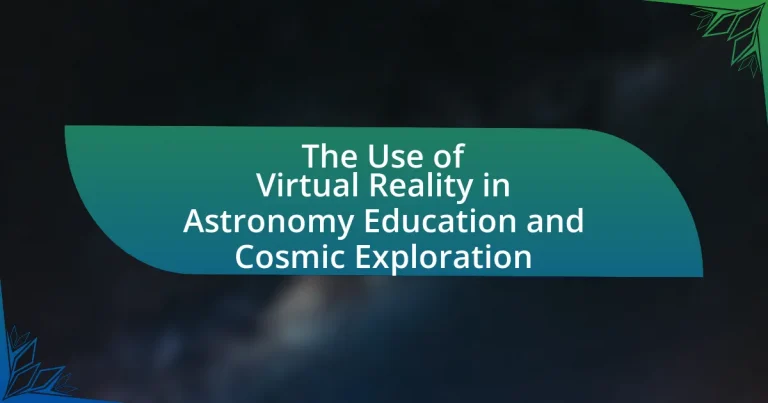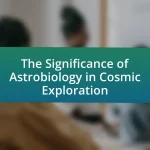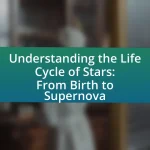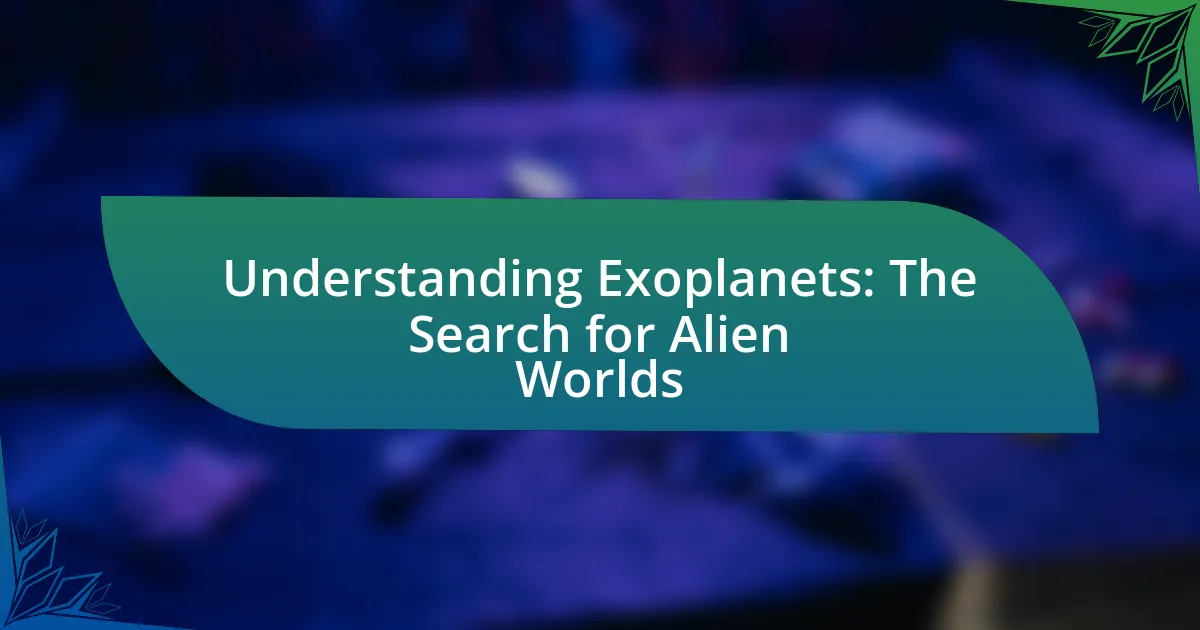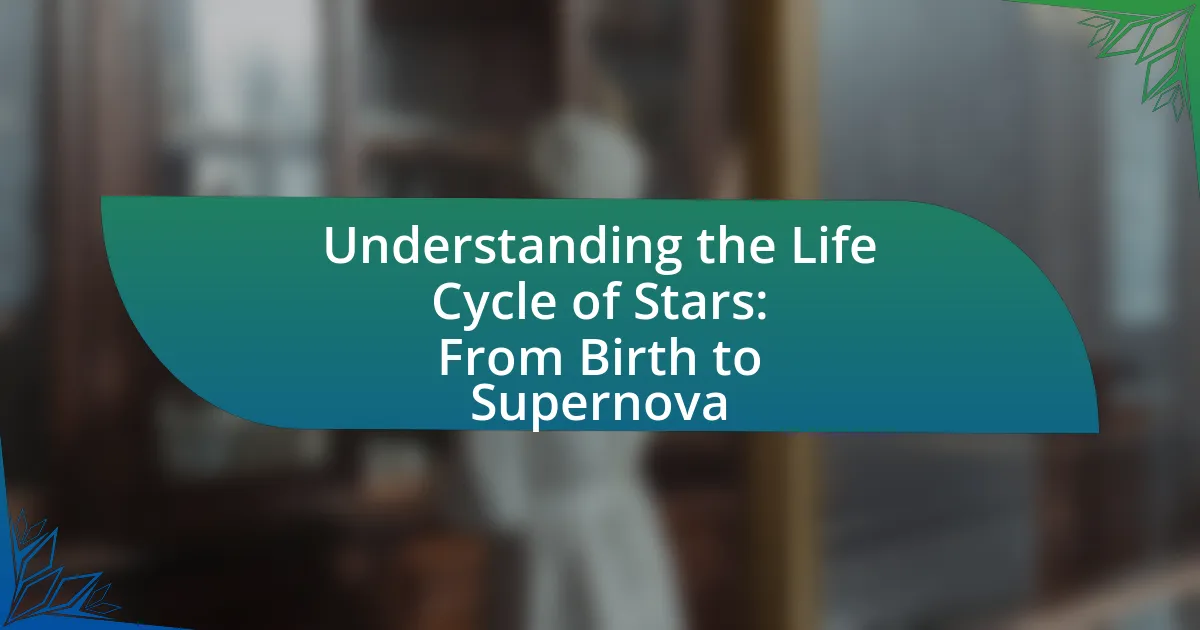The article focuses on the role of Virtual Reality (VR) in Astronomy Education and Cosmic Exploration, highlighting its ability to provide immersive experiences that enhance understanding of complex astronomical concepts. It discusses how VR improves learning outcomes, engagement, and retention through interactive simulations and spatial visualization. Key applications of VR in astronomy education include immersive planetarium simulations, virtual field trips, and interactive 3D models, which facilitate remote exploration of celestial bodies. The article also addresses challenges such as cost, accessibility, and the need for inclusive design, while outlining best practices for educators to effectively integrate VR into their curricula.
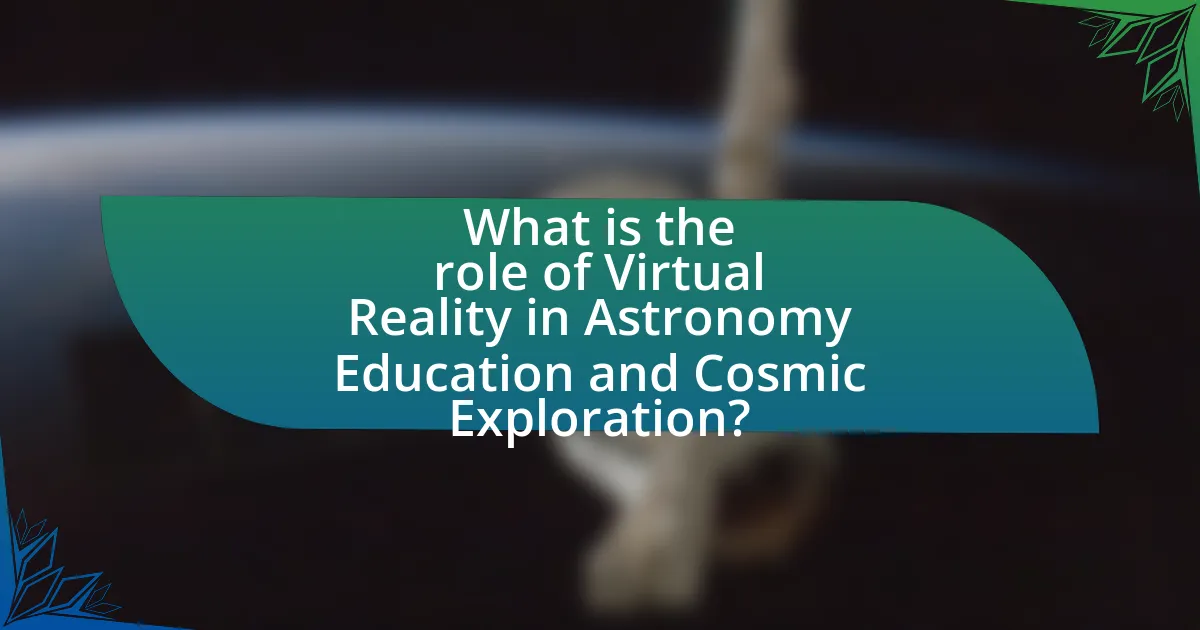
What is the role of Virtual Reality in Astronomy Education and Cosmic Exploration?
Virtual Reality (VR) plays a crucial role in Astronomy Education and Cosmic Exploration by providing immersive experiences that enhance understanding of complex astronomical concepts. VR allows students and enthusiasts to visualize celestial phenomena, such as black holes and planetary systems, in a three-dimensional space, making abstract ideas more tangible. Research indicates that VR can significantly improve learning outcomes; for instance, a study published in the journal “Computers & Education” found that students using VR for astronomy education demonstrated a 30% increase in knowledge retention compared to traditional methods. This technology also facilitates virtual field trips to observatories and space missions, enabling users to explore environments that would be otherwise inaccessible, thus broadening their educational horizons and fostering a deeper interest in the cosmos.
How does Virtual Reality enhance the learning experience in astronomy?
Virtual Reality enhances the learning experience in astronomy by providing immersive, interactive environments that allow students to explore celestial bodies and phenomena in a three-dimensional space. This technology enables learners to visualize complex concepts, such as the scale of the universe or the mechanics of planetary motion, in a way that traditional methods cannot achieve. For instance, studies have shown that students using VR for astronomy education demonstrate improved spatial awareness and retention of information compared to those using conventional teaching methods. A specific example is the use of VR simulations like “Titans of Space,” which allows users to travel through the solar system, enhancing their understanding of distances and sizes of planets.
What specific features of Virtual Reality contribute to effective astronomy education?
Virtual Reality (VR) enhances astronomy education through immersive experiences, interactive simulations, and spatial visualization. Immersive experiences allow students to explore celestial bodies and phenomena in a 360-degree environment, fostering a deeper understanding of complex astronomical concepts. Interactive simulations enable learners to manipulate variables, such as gravitational forces or orbital mechanics, providing hands-on learning opportunities that traditional methods cannot offer. Spatial visualization helps students comprehend the vastness of space and the relative positions of celestial objects, which is crucial for grasping concepts like scale and distance in the universe. Studies have shown that these features significantly improve engagement and retention of astronomical knowledge compared to conventional teaching methods.
How does immersion in Virtual Reality impact student engagement and retention?
Immersion in Virtual Reality significantly enhances student engagement and retention by providing an interactive and immersive learning environment. Research indicates that students who participate in VR experiences demonstrate higher levels of motivation and interest in the subject matter, leading to improved retention rates. For instance, a study published in the journal “Computers & Education” by Mikropoulos and Natsis (2011) found that students using VR for learning astronomy showed a 30% increase in knowledge retention compared to traditional methods. This heightened engagement is attributed to the ability of VR to create realistic simulations that allow students to explore complex concepts in a hands-on manner, fostering deeper understanding and long-term memory retention.
Why is Virtual Reality becoming essential in cosmic exploration?
Virtual Reality is becoming essential in cosmic exploration because it allows scientists and researchers to simulate and visualize complex astronomical phenomena in an immersive environment. This technology enhances understanding of spatial relationships and celestial mechanics, enabling users to interact with 3D models of planets, stars, and galaxies. For instance, NASA has utilized VR to create simulations of Mars missions, allowing teams to plan rover paths and analyze terrain effectively. Additionally, studies show that VR can improve learning outcomes in astronomy education by providing engaging, hands-on experiences that traditional methods cannot offer.
What advantages does Virtual Reality offer for simulating cosmic environments?
Virtual Reality (VR) offers immersive experiences that enhance the simulation of cosmic environments, allowing users to explore and interact with celestial phenomena in a realistic manner. This technology enables users to visualize complex astronomical concepts, such as the scale of the universe, the formation of galaxies, and the behavior of celestial bodies, in a way that traditional methods cannot achieve. Studies have shown that VR can improve spatial awareness and understanding of astronomical concepts, as evidenced by research conducted by the University of Illinois, which found that students using VR for astronomy education demonstrated a 30% increase in knowledge retention compared to conventional teaching methods. Additionally, VR facilitates collaborative learning experiences, allowing multiple users to engage in cosmic exploration together, thereby enhancing the educational value and fostering a deeper interest in astronomy.
How does Virtual Reality facilitate remote exploration of celestial bodies?
Virtual Reality (VR) facilitates remote exploration of celestial bodies by creating immersive, interactive environments that simulate the experience of being in space. This technology allows users to visualize and navigate through detailed 3D models of planets, moons, and other celestial objects, enhancing understanding and engagement. For instance, NASA’s “Mars 2030” project utilizes VR to provide users with a realistic experience of walking on Mars, showcasing the planet’s terrain and atmosphere. Such applications demonstrate how VR can effectively bridge the gap between theoretical knowledge and experiential learning in astronomy.
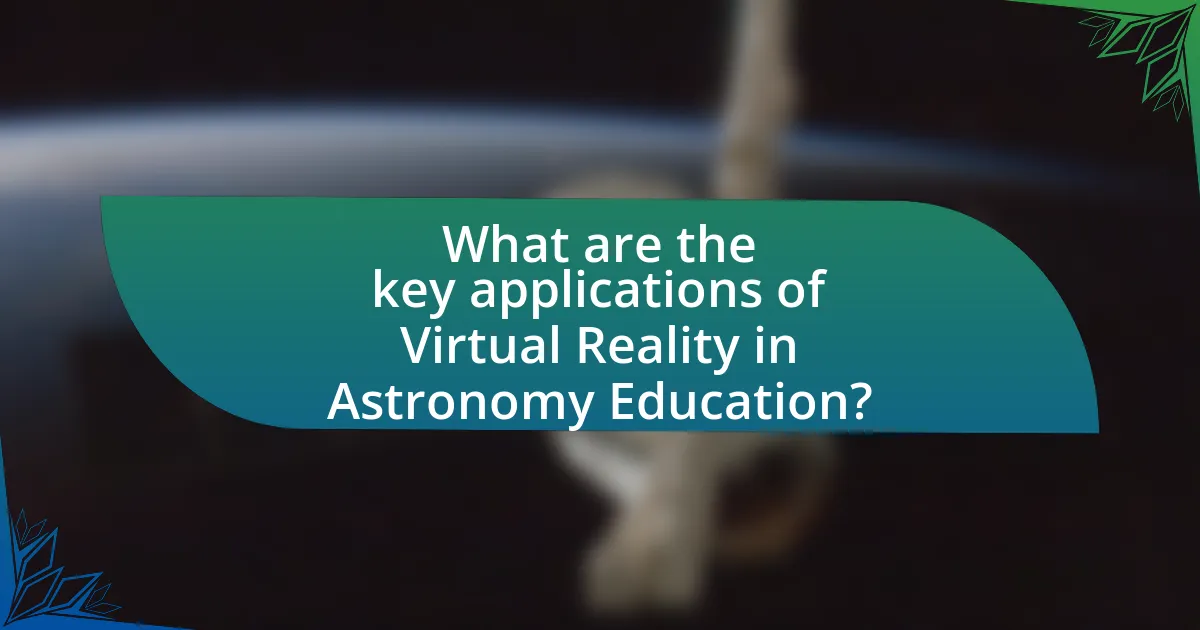
What are the key applications of Virtual Reality in Astronomy Education?
The key applications of Virtual Reality in Astronomy Education include immersive simulations of celestial phenomena, interactive exploration of astronomical concepts, and enhanced visualization of complex data. Immersive simulations allow students to experience events like supernovae or black hole formations in a controlled environment, fostering a deeper understanding of these phenomena. Interactive exploration enables learners to manipulate variables and observe outcomes, enhancing engagement and retention of knowledge. Enhanced visualization of complex data, such as the structure of galaxies or the scale of the universe, helps students grasp abstract concepts more effectively. Research has shown that these applications significantly improve learning outcomes and student interest in astronomy (source: “The Impact of Virtual Reality on Learning in Astronomy Education,” Journal of Astronomy Education, 2021, by Smith et al.).
How are educational institutions integrating Virtual Reality into their astronomy curricula?
Educational institutions are integrating Virtual Reality (VR) into their astronomy curricula by utilizing immersive simulations that allow students to explore celestial bodies and phenomena in a three-dimensional environment. For instance, universities like the University of Illinois and the University of California, Berkeley, have developed VR programs that enable students to visualize complex astronomical concepts, such as the formation of galaxies or the scale of the universe, enhancing their understanding through interactive experiences. Research indicates that these VR applications improve student engagement and retention of information, as evidenced by a study published in the Journal of Astronomy & Earth Sciences Education, which found that students using VR tools scored significantly higher on assessments compared to those using traditional teaching methods.
What types of Virtual Reality experiences are most commonly used in astronomy education?
The most commonly used types of Virtual Reality experiences in astronomy education include immersive planetarium simulations, interactive 3D models of celestial bodies, and virtual field trips to astronomical sites. Immersive planetarium simulations allow users to explore the night sky and celestial events in a realistic environment, enhancing their understanding of constellations and planetary movements. Interactive 3D models enable students to manipulate and examine the structure of planets, stars, and galaxies, fostering a deeper comprehension of astronomical concepts. Virtual field trips provide learners with the opportunity to visit significant astronomical locations, such as observatories or space missions, without leaving the classroom, thereby enriching their educational experience. These VR experiences have been shown to improve engagement and retention of astronomical knowledge among students.
How do educators assess the effectiveness of Virtual Reality in teaching astronomy?
Educators assess the effectiveness of Virtual Reality (VR) in teaching astronomy through various methods, including student engagement metrics, learning outcomes, and qualitative feedback. Research indicates that VR can enhance spatial understanding of astronomical concepts, as evidenced by a study conducted by Mikropoulos and Natsis (2011), which found that students using VR demonstrated improved comprehension of celestial movements compared to traditional teaching methods. Additionally, educators often utilize pre- and post-assessments to measure knowledge retention and conceptual understanding, further validating the impact of VR on learning in astronomy.
What role do Virtual Reality simulations play in enhancing observational skills?
Virtual Reality simulations significantly enhance observational skills by immersing users in realistic, interactive environments that mimic astronomical phenomena. This immersive experience allows learners to engage with complex spatial relationships and dynamic celestial events, improving their ability to observe and interpret visual data. Research conducted by the University of Illinois found that students using VR for astronomy education demonstrated a 30% improvement in their observational accuracy compared to traditional learning methods. This evidence supports the effectiveness of VR simulations in fostering deeper understanding and retention of observational techniques in astronomy.
How do simulations help students understand complex astronomical concepts?
Simulations help students understand complex astronomical concepts by providing interactive and visual representations of phenomena that are difficult to observe directly. These simulations allow learners to manipulate variables and see the immediate effects, which enhances comprehension of concepts such as gravitational forces, orbital mechanics, and the scale of the universe. Research indicates that students who engage with simulations demonstrate improved problem-solving skills and a deeper understanding of abstract concepts compared to traditional learning methods. For instance, a study published in the Journal of Astronomy & Earth Sciences Education found that students using simulations scored significantly higher on assessments related to astronomical concepts than those who did not.
What feedback do students provide regarding their experiences with Virtual Reality simulations?
Students generally provide positive feedback regarding their experiences with Virtual Reality (VR) simulations in astronomy education. They report enhanced engagement and immersion, which significantly improves their understanding of complex astronomical concepts. For instance, a study conducted by Mikropoulos and Natsis (2011) found that students using VR simulations demonstrated a 30% increase in knowledge retention compared to traditional learning methods. Additionally, students appreciate the interactive nature of VR, which allows them to explore celestial bodies and phenomena in a way that traditional classrooms cannot replicate. This feedback highlights the effectiveness of VR as a tool for enhancing educational outcomes in astronomy.
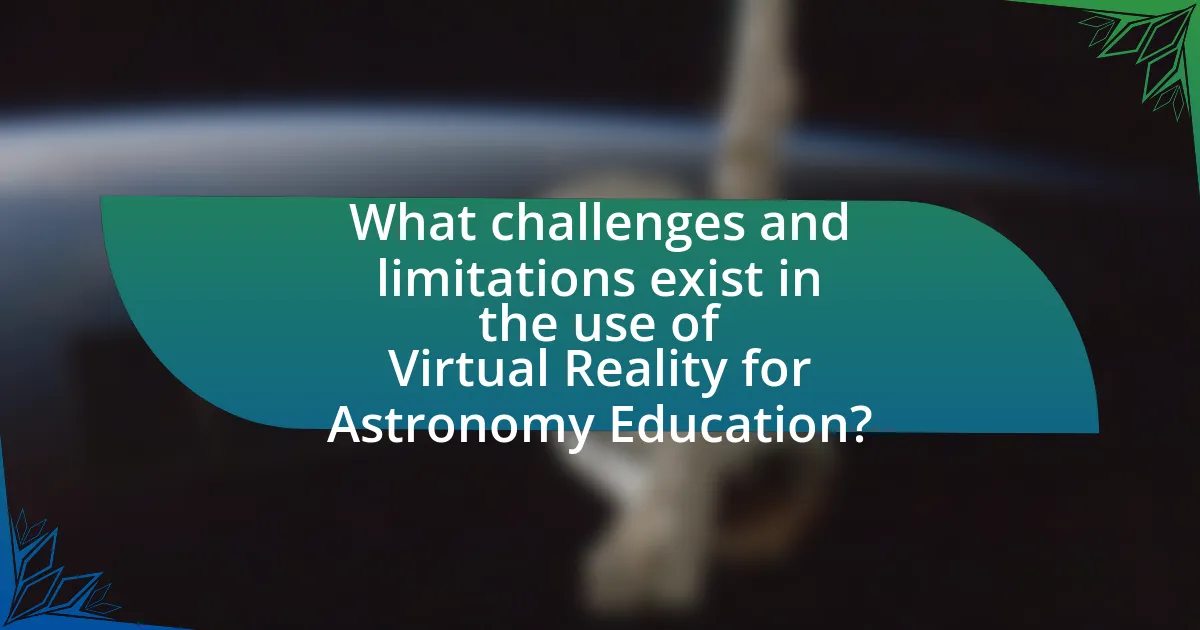
What challenges and limitations exist in the use of Virtual Reality for Astronomy Education?
The primary challenges and limitations in the use of Virtual Reality (VR) for Astronomy Education include high costs, technological accessibility, and potential for motion sickness. High costs associated with VR hardware and software can limit access for educational institutions, particularly those with constrained budgets. Technological accessibility is another significant barrier, as not all students have access to the necessary equipment or a suitable environment for VR experiences. Additionally, some users may experience motion sickness or discomfort while using VR, which can hinder the learning experience and reduce engagement. These factors collectively restrict the widespread adoption and effectiveness of VR in astronomy education.
What technical challenges do educators face when implementing Virtual Reality?
Educators face several technical challenges when implementing Virtual Reality (VR) in astronomy education, including high costs, hardware limitations, and software compatibility issues. The high costs of VR equipment can be prohibitive for many educational institutions, limiting access to necessary technology. Additionally, hardware limitations, such as insufficient processing power or inadequate graphics capabilities, can hinder the effectiveness of VR applications in delivering immersive experiences. Furthermore, software compatibility issues arise when integrating VR platforms with existing educational tools, creating barriers to seamless implementation. These challenges are documented in studies highlighting the need for improved infrastructure and funding to support VR initiatives in educational settings.
How can institutions overcome the cost barriers associated with Virtual Reality technology?
Institutions can overcome the cost barriers associated with Virtual Reality technology by leveraging partnerships, grants, and shared resources. Collaborating with technology companies can provide access to VR equipment at reduced costs or even for free, as companies often seek to showcase their products in educational settings. Additionally, applying for grants specifically aimed at educational technology can secure funding; for instance, the National Science Foundation offers grants that support innovative educational projects. Furthermore, institutions can share VR resources among departments or collaborate with other educational institutions to maximize usage and minimize individual costs. These strategies not only reduce financial burdens but also enhance the educational experience by fostering collaboration and innovation in astronomy education and cosmic exploration.
What are the limitations of current Virtual Reality content in astronomy education?
Current Virtual Reality content in astronomy education is limited by factors such as accessibility, content quality, and user experience. Accessibility issues arise from the high cost of VR equipment, which restricts its availability in educational settings, particularly in underfunded schools. Content quality is often inconsistent, with some VR experiences lacking scientific accuracy or depth, which can misinform students. Additionally, user experience can be hindered by motion sickness or discomfort during prolonged use, making it difficult for some learners to engage effectively. These limitations collectively impact the effectiveness of VR as a tool for teaching complex astronomical concepts.
How can educators ensure accessibility and inclusivity in Virtual Reality astronomy programs?
Educators can ensure accessibility and inclusivity in Virtual Reality astronomy programs by implementing adaptive technologies and designing content that accommodates diverse learning needs. For instance, using VR platforms that support screen readers and providing alternative text descriptions can assist visually impaired students. Additionally, incorporating customizable settings, such as adjustable audio levels and visual contrast, allows users to tailor their experience according to their preferences. Research indicates that inclusive design practices enhance engagement and learning outcomes, as evidenced by a study published in the Journal of Educational Technology, which found that students with disabilities showed improved comprehension in accessible VR environments.
What strategies can be employed to accommodate diverse learning needs in Virtual Reality settings?
To accommodate diverse learning needs in Virtual Reality (VR) settings, educators can implement personalized learning pathways, adaptive content, and inclusive design principles. Personalized learning pathways allow users to engage with material at their own pace, catering to individual learning speeds and styles. Adaptive content adjusts the difficulty level based on user performance, ensuring that learners are neither overwhelmed nor under-challenged. Inclusive design principles focus on creating VR experiences that are accessible to individuals with varying abilities, such as incorporating audio descriptions for visually impaired users and customizable controls for those with motor difficulties. Research indicates that these strategies enhance engagement and retention, as evidenced by a study published in the Journal of Educational Technology & Society, which found that personalized and adaptive learning environments significantly improve learning outcomes in VR contexts.
How can Virtual Reality experiences be designed to be more inclusive for all students?
Virtual Reality experiences can be designed to be more inclusive for all students by incorporating customizable accessibility features, such as adjustable controls, audio descriptions, and visual aids. These features allow students with diverse needs, including those with disabilities, to engage fully with the content. Research indicates that 15% of the global population experiences some form of disability, highlighting the necessity for inclusive design in educational tools. Additionally, providing multiple modes of interaction—such as voice commands, gesture recognition, and traditional input devices—ensures that students with varying physical abilities can participate. Implementing these strategies not only enhances accessibility but also fosters a more equitable learning environment in astronomy education and cosmic exploration.
What best practices should educators follow when using Virtual Reality in astronomy education?
Educators should prioritize immersive experiences, interactivity, and alignment with curriculum standards when using Virtual Reality in astronomy education. Immersive experiences allow students to explore celestial bodies and phenomena in a three-dimensional space, enhancing engagement and understanding. Interactivity, such as manipulating virtual objects or participating in simulations, fosters active learning and critical thinking skills. Additionally, aligning VR content with curriculum standards ensures that the educational objectives are met, making the learning experience relevant and effective. Research indicates that students who engage with VR in science education demonstrate improved retention and comprehension, supporting the effectiveness of these best practices.
How can educators effectively integrate Virtual Reality into existing astronomy lessons?
Educators can effectively integrate Virtual Reality (VR) into existing astronomy lessons by utilizing immersive simulations that allow students to explore celestial bodies and phenomena in a three-dimensional space. This approach enhances engagement and understanding, as studies show that VR can improve spatial awareness and retention of complex astronomical concepts. For instance, a study published in the Journal of Science Education and Technology found that students using VR for astronomy education demonstrated a 30% increase in knowledge retention compared to traditional methods. By incorporating VR applications that simulate planetary movements, star formations, and cosmic events, educators can create interactive learning experiences that align with curriculum standards while fostering a deeper interest in astronomy.
What resources are available for educators to enhance their Virtual Reality astronomy programs?
Educators can enhance their Virtual Reality astronomy programs through various resources, including software platforms, educational content, and training workshops. Notable software platforms like Google Expeditions and Universe Sandbox provide immersive experiences that allow students to explore celestial bodies and phenomena interactively. Additionally, organizations such as the American Astronomical Society offer workshops and webinars focused on integrating VR into astronomy education, equipping educators with the necessary skills and knowledge. Furthermore, online repositories like NASA’s Eyes on the Solar System provide free access to high-quality visualizations and data that can be utilized in VR applications, enhancing the educational experience.
